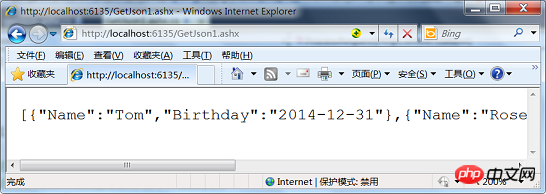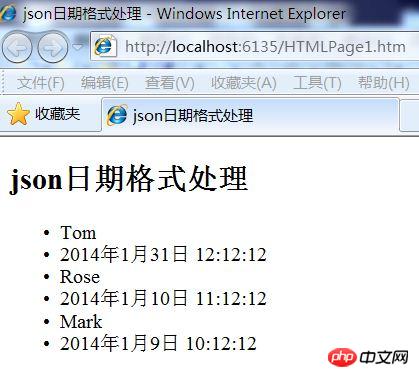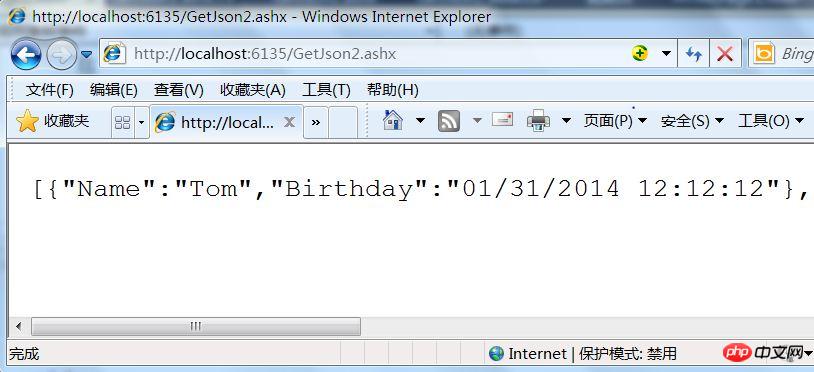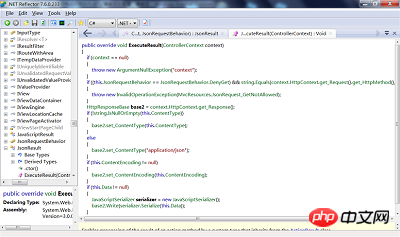Format de date d'opération Json
Cette fois je vais vous présenter le format de date d'opération Json. Quelles sont les précautions pour le format de date d'opération Json. Voici un cas pratique, jetons un coup d'oeil.
Pendant le développement, il est parfois nécessaire de renvoyer des données au format json depuis le serveur. S'il y a des données de type DateTime dans le code d'arrière-plan, elles seront sérialisées à l'aide de la propre classe d'outils du système et un numéro long sera obtenu pour représenter les données de date, comme indiqué ci-dessous :
//设置服务器响应的结果为纯文本格式
context.Response.ContentType = "text/plain";
//学生对象集合
List<Student> students = new List<Student>
{
new Student(){Name ="Tom",
Birthday =Convert.ToDateTime("2014-01-31 12:12:12")},
new Student(){Name ="Rose",
Birthday =Convert.ToDateTime("2014-01-10 11:12:12")},
new Student(){Name ="Mark",
Birthday =Convert.ToDateTime("2014-01-09 10:12:12")}
};
//javascript序列化器
JavaScriptSerializer jss=new JavaScriptSerializer();
//序列化学生集合对象得到json字符
string studentsJson=jss.Serialize(students);
//将字符串响应到客户端
context.Response.Write(studentsJson);
context.Response.End();Le résultat courant est :

où l'anniversaire correspondant de Tom "2014". -01-31" devient Nous avons obtenu 1391141532000, qui est en fait le nombre de millisecondes depuis le 1er janvier 1970 ; 1391141532000/1000/60/60/24/365=44,11 ans, 44+1970=2014 ans, cette méthode peut obtenir le année, mois, jour, heure et minute, secondes et millisecondes. Ce format est une représentation réalisable mais pas un format convivial que les gens ordinaires peuvent comprendre. Comment changer ce format ?
Solution :
Méthode 1 : utilisez la méthode Select côté serveur pour modifier la date format Ou l'expression LINQ est convertie et envoyée au client :
using System;
using System.Collections.Generic;
using System.Web;
using System.Web.Script.Serialization;
namespace JsonDate1
{
using System.Linq;
/// <summary>
/// 学生类,测试用
/// </summary>
public class Student
{
/// <summary>
/// 姓名
/// </summary>
public String Name { get; set; }
/// <summary>
/// 生日
/// </summary>
public DateTime Birthday { get; set; }
}
/// <summary>
/// 返回学生集合的json字符
/// </summary>
public class GetJson : IHttpHandler
{
public void ProcessRequest(HttpContext context)
{
//设置服务器响应的结果为纯文本格式
context.Response.ContentType = "text/plain";
//学生对象集合
List<Student> students = new List<Student>
{
new Student(){Name ="Tom",Birthday =Convert.ToDateTime("2014-01-31 12:12:12")},
new Student(){Name ="Rose",Birthday =Convert.ToDateTime("2014-01-10 11:12:12")},
new Student(){Name ="Mark",Birthday =Convert.ToDateTime("2014-01-09 10:12:12")}
};
//使用Select方法重新投影对象集合将Birthday属性转换成一个新的属性
//注意属性变化后要重新命名,并立即执行
var studentSet =
students.Select
(
p => new { p.Name, Birthday = p.Birthday.ToString("yyyy-mm-dd") }
).ToList();
//javascript序列化器
JavaScriptSerializer jss = new JavaScriptSerializer();
//序列化学生集合对象得到json字符
string studentsJson = jss.Serialize(studentSet);
//将字符串响应到客户端
context.Response.Write(studentsJson);
context.Response.End();
}
public bool IsReusable
{
get
{
return false;
}
}
}
}La méthode Select reprojete la collection d'objets et convertit l'attribut Birthday en un nouvel attribut. le nom doit être renommé après les changements d'attribut. Cela peut être le même ; ici, vous pouvez utiliser la méthode select ou l'expression de requête LINQ, ou vous pouvez choisir d'autres méthodes pour atteindre le même objectif, cette méthode peut supprimer les attributs qui ne sont pas utilisés par ; le client dans la collection pour atteindre l'objectif d'optimiser simplement les performances.
Résultat de l'exécution :

Le format de date à ce moment est devenu un format convivial, mais en javascript, ce n'est qu'une chaîne.
Méthode 2 :
Convertir la chaîne dans "Birthday":/Date(1391141532000)/" en un objet date en javascript. Vous pouvez supprimer le non-. caractères numériques dans la Valeur correspondant à la Clé Anniversaire en les remplaçant jusqu'à ce qu'ils atteignent un nombre 1391141532000. Instanciez ensuite un objet Date et utilisez 1391141532000 millisecondes comme paramètre pour obtenir un objet date en JavaScript. Le code est le suivant :
<.><!DOCTYPE html>
<html xmlns="http://www.w3.org/1999/xhtml">
<head>
<title>json日期格式处理</title>
<script src="Scripts/jquery-1.10.2.min.js" type="text/javascript"></script>
<script type="text/javascript">
$(function() {
$.getJSON("getJson.ashx", function (students) {
$.each(students, function (index, obj) {
$("<li/>").html(obj.Name).appendTo("#ulStudents");
//使用正则表达式将生日属性中的非数字(\D)删除
//并把得到的毫秒数转换成数字类型
var birthdayMilliseconds = parseInt(obj.Birthday.replace(/\D/igm, ""));
//实例化一个新的日期格式,使用1970 年 1 月 1 日至今的毫秒数为参数
var birthday = new Date(birthdayMilliseconds);
$("<li/>").html(birthday.toLocaleString()).appendTo("#ulStudents"); ;
});
});
});
</script>
</head>
<body>
<h2>json日期格式处理</h2>
<ul id="ulStudents">
</ul>
</body>
</html>
$(function () {
$.getJSON("getJson.ashx", function (students) {
$.each(students, function (index, obj) {
$("<li/>").html(obj.Name).appendTo("#ulStudents");
//使用正则表达式将生日属性中的非数字(\D)删除
//并把得到的毫秒数转换成数字类型
var birthdayMilliseconds = parseInt(obj.Birthday.replace(/\D/igm, ""));
//实例化一个新的日期格式,使用1970 年 1 月 1 日至今的毫秒数为参数
var birthday = new Date(birthdayMilliseconds);
$("<li/>").html(birthday.toLocaleString()).appendTo("#ulStudents");
$("<li/>").html(obj.Birthday.toDate()).appendTo("#ulStudents");
});
});
});
//在String对象中扩展一个toDate方法,可以根据要求完善
String.prototype.toDate = function () {
var dateMilliseconds;
if (isNaN(this)) {
//使用正则表达式将日期属性中的非数字(\D)删除
dateMilliseconds =this.replace(/\D/igm, "");
} else {
dateMilliseconds=this;
}
//实例化一个新的日期格式,使用1970 年 1 月 1 日至今的毫秒数为参数
return new Date(parseInt(dateMilliseconds));
};Méthode 3 :
Vous pouvez choisir des classes d'outils JSON tierces, dont beaucoup ont déjà traité des problèmes de format de date, les plus courantsSérialisation Json et les bibliothèques d'outils de désérialisation incluent :
1.fastJSON.2.JSON_checker.
3.Jayrock.
4.Json.NET - LINQ to JSON.
5 .LitJSON.
6.JSON pour .NET.
7.JsonFx.
8.JSONSharp.
9.JsonExSerializer.
10.fluent-json
11.Manatee Json
using System;
using System.Collections.Generic;
using System.Web;
using LitJson;
namespace JsonDate2
{
using System.Linq;
/// <summary>
/// 学生类,测试用
/// </summary>
public class Student
{
/// <summary>
/// 姓名
/// </summary>
public String Name { get; set; }
/// <summary>
/// 生日
/// </summary>
public DateTime Birthday { get; set; }
}
/// <summary>
/// 返回学生集合的json字符
/// </summary>
public class GetJson : IHttpHandler
{
public void ProcessRequest(HttpContext context)
{
//设置服务器响应的结果为纯文本格式
context.Response.ContentType = "text/plain";
//学生对象集合
List<Student> students = new List<Student>
{
new Student(){Name ="Tom",Birthday =Convert.ToDateTime("2014-01-31 12:12:12")},
new Student(){Name ="Rose",Birthday =Convert.ToDateTime("2014-01-10 11:12:12")},
new Student(){Name ="Mark",Birthday =Convert.ToDateTime("2014-01-09 10:12:12")}
};
//序列化学生集合对象得到json字符
string studentsJson = JsonMapper.ToJson(students);
//将字符串响应到客户端
context.Response.Write(studentsJson);
context.Response.End();
}
public bool IsReusable
{
get
{
return false;
}
}
}
}. 
var date = new Date("01/31/2014 12:12:12");
alert(date.toLocaleString());$(function () {
$.getJSON("GetJson2.ashx", function (students) {
$.each(students, function (index, obj) {
$("<li/>").html(obj.Name).appendTo("#ulStudents");
var birthday = new Date(obj.Birthday);
$("<li/>").html(birthday.toLocaleString()).appendTo("#ulStudents");
});
});
});
var date = new Date("01/31/2014 12:12:12");
alert(date.toLocaleString());Ce texte a été publié sur le blog et les internautes ont émis leurs précieux avis. Je n'ai pas pris en compte la situation dans MVC. En fait, il peut également être utilisé dans MVC. gestionnaire, donc la différence n'est pas très grande, mais il y a une action dans MVC spécifiquement pour la réponse du serveur à JSON, le code est le suivant :
Résultat d'exécution :using System;
using System.Web.Mvc;
namespace JSONDateMVC.Controllers
{
public class HomeController : Controller
{
public JsonResult GetJson1()
{
//序列化当前日期与时间对象,并允许客户端Get请求
return Json(DateTime.Now, JsonRequestBehavior.AllowGet);
}
}
}下载一个内容为Application/json的文件,文件名为GetJson1,内容是"\/Date(1391418272884)\/"
从上面的情况看来MVC中序列化时并未对日期格式特别处理,我们可以反编译看源码:
Return调用的Json方法:
protected internal JsonResult Json(object data, JsonRequestBehavior behavior)
{
return this.Json(data, null, null, behavior);
}
this.Json方法
protected internal virtual JsonResult Json(object data, string contentType, Encoding contentEncoding, JsonRequestBehavior behavior)
{
return new JsonResult { Data = data, ContentType = contentType, ContentEncoding = contentEncoding, JsonRequestBehavior = behavior };
}JsonResult类ActionResult类的子类,ExecuteResult方法:

从上面的代码中不难看出微软的JsonResult类仍然是使用了JavaScriptSerializer,所以返回的结果与方法一未处理时是一样的,要解决这个问题我们可以派生出一个新的类,重写ExecuteResult方法,使用Json.net来完成序列化工作,JsonResultPro.cs文件的代码如下:
namespace JSONDateMVC.Common
{
using System;
using System.Web;
using System.Web.Mvc;
using Newtonsoft.Json;
using Newtonsoft.Json.Converters;
public class JsonResultPro : JsonResult
{
public JsonResultPro(){}
public JsonResultPro(object data, JsonRequestBehavior behavior)
{
base.Data = data;
base.JsonRequestBehavior = behavior;
this.DateTimeFormat = "yyyy-MM-dd hh:mm:ss";
}
public JsonResultPro(object data, String dateTimeFormat)
{
base.Data = data;
base.JsonRequestBehavior = JsonRequestBehavior.AllowGet;
this.DateTimeFormat = dateTimeFormat;
}
/// <summary>
/// 日期格式
/// </summary>
public string DateTimeFormat{ get; set; }
public override void ExecuteResult(ControllerContext context)
{
if (context == null)
{
throw new ArgumentNullException("context");
}
if ((this.JsonRequestBehavior == JsonRequestBehavior.DenyGet) && string.Equals(context.HttpContext.Request.HttpMethod, "GET", StringComparison.OrdinalIgnoreCase))
{
throw new InvalidOperationException("MvcResources.JsonRequest_GetNotAllowed");
}
HttpResponseBase base2 = context.HttpContext.Response;
if (!string.IsNullOrEmpty(this.ContentType))
{
base2.ContentType = this.ContentType;
}
else
{
base2.ContentType = "application/json";
}
if (this.ContentEncoding != null)
{
base2.ContentEncoding = this.ContentEncoding;
}
if (this.Data != null)
{
//转换System.DateTime的日期格式到 ISO 8601日期格式
//ISO 8601 (如2008-04-12T12:53Z)
IsoDateTimeConverter isoDateTimeConverter=new IsoDateTimeConverter();
//设置日期格式
isoDateTimeConverter.DateTimeFormat = DateTimeFormat;
//序列化
String jsonResult = JsonConvert.SerializeObject(this.Data,isoDateTimeConverter);
//相应结果
base2.Write(jsonResult);
}
}
}
}使用上面的JsonResultPro Action类型的代码如下:
public JsonResultPro GetJson2()
{
//序列化当前日期与时间对象,并允许客户端Get请求,注意H是大写
return new JsonResultPro(DateTime.Now,"yyyy-MM-dd HH:mm");
}相信看了本文案例你已经掌握了方法,更多精彩请关注php中文网其它相关文章!
推荐阅读:
Ce qui précède est le contenu détaillé de. pour plus d'informations, suivez d'autres articles connexes sur le site Web de PHP en chinois!

Outils d'IA chauds

Undresser.AI Undress
Application basée sur l'IA pour créer des photos de nu réalistes

AI Clothes Remover
Outil d'IA en ligne pour supprimer les vêtements des photos.

Undress AI Tool
Images de déshabillage gratuites

Clothoff.io
Dissolvant de vêtements AI

AI Hentai Generator
Générez AI Hentai gratuitement.

Article chaud

Outils chauds

Bloc-notes++7.3.1
Éditeur de code facile à utiliser et gratuit

SublimeText3 version chinoise
Version chinoise, très simple à utiliser

Envoyer Studio 13.0.1
Puissant environnement de développement intégré PHP

Dreamweaver CS6
Outils de développement Web visuel

SublimeText3 version Mac
Logiciel d'édition de code au niveau de Dieu (SublimeText3)

Sujets chauds
 Comment écrire le format de boîte aux lettres qq ? Qu'est-ce que le format de boîte aux lettres qq ?
Feb 22, 2024 pm 03:40 PM
Comment écrire le format de boîte aux lettres qq ? Qu'est-ce que le format de boîte aux lettres qq ?
Feb 22, 2024 pm 03:40 PM
E-mail QQ : QQ number@qq.com, anglais QQ email : anglais ou number@qq.com, compte de messagerie foxmail : créez votre propre compte@foxmail.com, compte de messagerie de téléphone mobile : numéro de téléphone mobile@qq.com. Tutoriel Modèle applicable : iPhone13 Système : IOS15.3 Version : QQ Mailbox 6.3.3 Analyse La boîte aux lettres 1QQ a quatre formats, boîte aux lettres QQ couramment utilisée : QQ number@qq.com, anglais Boîte aux lettres QQ : anglais ou number@qq.com, foxmail Email compte : créez votre propre compte@foxmail.com, compte de messagerie de téléphone mobile : numéro de téléphone mobile@qq.com. Supplément : Qu'est-ce que la boîte aux lettres QQ ? 1 La première boîte aux lettres QQ était réservée aux utilisateurs QQ.
 Quelle est la différence entre MySQL5.7 et MySQL8.0 ?
Feb 19, 2024 am 11:21 AM
Quelle est la différence entre MySQL5.7 et MySQL8.0 ?
Feb 19, 2024 am 11:21 AM
MySQL5.7 et MySQL8.0 sont deux versions différentes de la base de données MySQL. Il existe quelques différences principales entre elles : Améliorations des performances : MySQL8.0 présente quelques améliorations de performances par rapport à MySQL5.7. Ceux-ci incluent de meilleurs optimiseurs de requêtes, une génération de plans d'exécution de requêtes plus efficaces, de meilleurs algorithmes d'indexation et des requêtes parallèles, etc. Ces améliorations peuvent améliorer les performances des requêtes et les performances globales du système. Prise en charge JSON : MySQL 8.0 introduit la prise en charge native du type de données JSON, y compris le stockage, la requête et l'indexation des données JSON. Cela rend le traitement et la manipulation des données JSON dans MySQL plus pratiques et efficaces. Fonctionnalités de transaction : MySQL8.0 introduit de nouvelles fonctionnalités de transaction, telles que l'atome
 Conseils d'optimisation des performances pour la conversion de tableaux PHP en JSON
May 04, 2024 pm 06:15 PM
Conseils d'optimisation des performances pour la conversion de tableaux PHP en JSON
May 04, 2024 pm 06:15 PM
Les méthodes d'optimisation des performances pour la conversion des tableaux PHP en JSON incluent : l'utilisation d'extensions JSON et de la fonction json_encode() ; l'ajout de l'option JSON_UNESCAPED_UNICODE pour éviter l'échappement de caractères ; l'utilisation de tampons pour améliorer les performances d'encodage de boucle et l'utilisation d'un tiers ; Bibliothèque d'encodage JSON.
 Tutoriel d'utilisation de Pandas : Démarrage rapide pour la lecture de fichiers JSON
Jan 13, 2024 am 10:15 AM
Tutoriel d'utilisation de Pandas : Démarrage rapide pour la lecture de fichiers JSON
Jan 13, 2024 am 10:15 AM
Démarrage rapide : méthode Pandas de lecture des fichiers JSON, des exemples de code spécifiques sont requis Introduction : Dans le domaine de l'analyse des données et de la science des données, Pandas est l'une des bibliothèques Python importantes. Il fournit des fonctions riches et des structures de données flexibles, et peut facilement traiter et analyser diverses données. Dans les applications pratiques, nous rencontrons souvent des situations où nous devons lire des fichiers JSON. Cet article expliquera comment utiliser Pandas pour lire des fichiers JSON et joindra des exemples de code spécifiques. 1. Installation de Pandas
 Comment les annotations de la bibliothèque Jackson contrôlent-elles la sérialisation et la désérialisation JSON ?
May 06, 2024 pm 10:09 PM
Comment les annotations de la bibliothèque Jackson contrôlent-elles la sérialisation et la désérialisation JSON ?
May 06, 2024 pm 10:09 PM
Les annotations dans la bibliothèque Jackson contrôlent la sérialisation et la désérialisation JSON : Sérialisation : @JsonIgnore : Ignorer la propriété @JsonProperty : Spécifiez le nom @JsonGetter : Utilisez la méthode get @JsonSetter : Utilisez la méthode set Désérialisation : @JsonIgnoreProperties : Ignorez la propriété @ JsonProperty : Spécifiez le nom @JsonCreator : utilisez le constructeur @JsonDeserialize : logique personnalisée
 Compréhension approfondie de PHP : méthode d'implémentation de conversion de JSON Unicode en chinois
Mar 05, 2024 pm 02:48 PM
Compréhension approfondie de PHP : méthode d'implémentation de conversion de JSON Unicode en chinois
Mar 05, 2024 pm 02:48 PM
Compréhension approfondie de PHP : méthode d'implémentation de conversion de JSONUnicode en chinois Au cours du développement, nous rencontrons souvent des situations où nous devons traiter des données JSON, et l'encodage Unicode en JSON nous posera quelques problèmes dans certains scénarios, en particulier lorsqu'Unicode doit être converti Lorsque l'encodage est converti en caractères chinois. En PHP, certaines méthodes peuvent nous aider à réaliser ce processus de conversion. Une méthode courante sera présentée ci-dessous et des exemples de code spécifiques seront fournis. Tout d’abord, comprenons d’abord le Un en JSON
 format de chanson sur disque uefiu
Feb 12, 2024 pm 10:18 PM
format de chanson sur disque uefiu
Feb 12, 2024 pm 10:18 PM
Avec la mise à jour continue du système Win10, son image d'installation d'origine devient de plus en plus grande, ce qui pose des problèmes aux étudiants qui aiment utiliser le disque U pour l'installation de la méthode de démarrage UEFI. Comme nous le savons tous, si vous utilisez la méthode EFI pour installer le système, vous pouvez installer directement l'image Microsoft originale. Après la décompression, copiez-la dans le répertoire racine du disque U au format fat32 ou fat16, puis configurez directement le disque U de la carte mère pour démarrer l'installation. Cependant, récemment, de nombreux amis ont signalé que c'était le cas. contre-productif. Il existe une restriction sur l'utilisation du disque U au format fat, c'est-à-dire un seul fichier. Le maximum ne peut pas dépasser 4G, sinon il sera impossible d'écrire. Cependant, à mesure que l'image win10 augmente, le fichier install.wim. le package d'installation devient de plus en plus grand, dépassant la 4G, ce qui rend impossible son utilisation directe
 Conseils rapides pour convertir des tableaux PHP en JSON
May 03, 2024 pm 06:33 PM
Conseils rapides pour convertir des tableaux PHP en JSON
May 03, 2024 pm 06:33 PM
Les tableaux PHP peuvent être convertis en chaînes JSON via la fonction json_encode() (par exemple : $json=json_encode($array);), et inversement, la fonction json_decode() peut être utilisée pour convertir du JSON en tableaux ($array= json_decode($json);) . D'autres conseils incluent d'éviter les conversions profondes, de spécifier des options personnalisées et d'utiliser des bibliothèques tierces.






